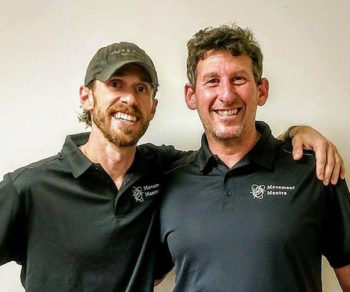
Dynamic Neuromuscular Assessment – DNA™ encompasses The Five Essential Skills that have a synergistic effect on the integration of breath, movement, and structure.
The Intrinsic Kinetic Chain (IKC), the KC focused on breath, has some qualities that require a complete assessment protocol. Many of the players in respiration cannot be evaluated using standard direct muscle testing strategies. Hybrid movement assessment – like DNA™ fills in the gaps left by direct testing strategies.
Hybrid Movement Assessment:
Hybrid movement assessment uses both direct and indirect manual muscle testing. This assessment protocol offers several advantages over direct manual muscle testing on its own, as it allows muscles to be evaluated that normally cannot be tested directly. Indirect testing has several advantages which I tease out a bit more below (and we go into great depth in the DNA™ Seminars).
Completing the Feed-Back Loop:
The feedback loop can be completed. We can evaluate both feed-back and feed-forward motor sequences using indirect testing methods.
Functional Dysfunctional Movement:
With indirect testing methods, we can look beyond “can this function respond” to “can this function respond appropriately.” Simply put, even if the body can engage, that doesn’t mean it can engage appropriately. We can have function with an underlying dysfunctional component. Response to movement has a spectrum. The spectrum of hypo-tonic to hyper-tonic is key to changing an inappropriate response to the movement environment to an appropriate response. Hybrid movement assessment takes our results a step further and can clarify otherwise confusing results.
Functional Compass:
The functional compass provides a road map for evaluating any joint in the body. The idea that we can isolate a muscle in movement is a false notion. We do have the capacity to isolate movement. Though we cannot isolate structure. Bones, joints, ligaments, tendons, muscles, fascia, and skin all work like a symphony to synergistically respond to movement. The functional compass provides the map to movement potential and helps us to understand the score of the symphony.
Eccentric Movement Assessment:
Movement has three key components. One is the concentric phase. This is where the “work” production occurs. The opposite component is the eccentric phase. This is where the structure dynamically stabilizes in deceleration. Eccentric movement protects joints at the end range of motion. The third component are the isometric stabilizers. The isometric stabilizers provide the dynamic support for both concentric work production and eccentric deceleration.
How do we apply The Five Essential Skills to the Subsystems (multifidus, TVA, thoracic and pelvic diaphragms) of the Intrinsic Kinetic Chain in DNA™ Seminars?
Multifidus:
The multifidus is a multi-segmental core spinal stabilizer. The multifidus unifies the function of the lumbar spine to the sacrum. There is a specific order to sequencing the spinal erectors and the multifidus. Here we learn to refine testing strategies and implement hybrid assessment with feed-back assessment.
Transverse Abdominus:
The TVA is a group of horizontal fibers that knit together the obliques and rectus abdominus. This is the introduction to the three pairings of musculature that make up the core cylinder. The core cylinder integration is necessary for the power generation of the anterior spiral kinetic chain. With TVA evaluation, we introduce completing the feed-back loop. Feed-forward assessment challenges the pressurization capacity of the core cylinder.
Thoracic Diaphragm:
The thoracic diaphragm separates the thorax and abdominal cavity. This dome-shaped muscle has two important roles. The first is to initiate pressurization changes that act on the lungs. The lungs are like sponges, and structural pressurization squeezes and soaks like a bellows bringing air to a fire. The second function is stability. The thoracic diaphragm works synergistically with all the compartments of the thoracolumbar fascia. The thoracic diaphragm cannot be tested directly, the movement that this muscle is responsible for can only be evaluated through hybrid assessment. We spend considerable time refining hybrid assessment during DNA™ Seminars.
Pelvic Diaphragm:
The pelvic diaphragm is the hammock for the visceral cavity. The pelvic diaphragm responds to pressurization changes initiated by the thoracic diaphragm. Similar to the thoracic diaphragm, the group of muscles that make up the pelvic diaphragm cannot be tested directly, the movement that these muscles are responsible for also can only be evaluated through hybrid assessment.
All four of the subsystem structures must have the capacity to function together as a team in a functional breathing apparatus. Evaluating the ability to work together as a team is a protocol called Long Series Kinetic Chain, LSKC – this assessment protocol is integral in DNA™ (read more in DNA Demystified and DNA – FAQs).
DNA™ is not a system where we try to see if a tool fits a presentation. That would be akin to seeing if the square peg fits the round hole. We use a more sophisticated approach that uses laser focus – through hybrid movement assessment – to ascertain what the nervous system needs so that the structure can integrate breath, structure, and movement.
The assessment skills I learned in DNA have proven invaluable with clients, especially athletes. I now have the ability to go beyond muscle testing and assess their feed-forward movement patterns. Learning how to uncover and treat breathing problems and hypertonic muscles has been a game-changer. Clients are getting faster, more lasting results because we’re finally uncovering the heart of their issue, which often means addressing ligament and joint issues. I use Joseph’s work every day and I’m so grateful to have taken his class. ~ Beth T., Breakaway Bodyworks, LMT
You’re invited to join us! Fin out about the next paradigm shift here.
Hi,
Your approach to assessing dysfunctions is very interesting to me, particularly the breathing portion. I’m a personal trainer and would like to know how to learn your approach to assess and correct dysfunctions in the human body.
Best.
Nathan